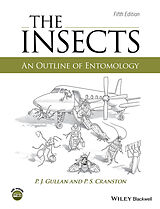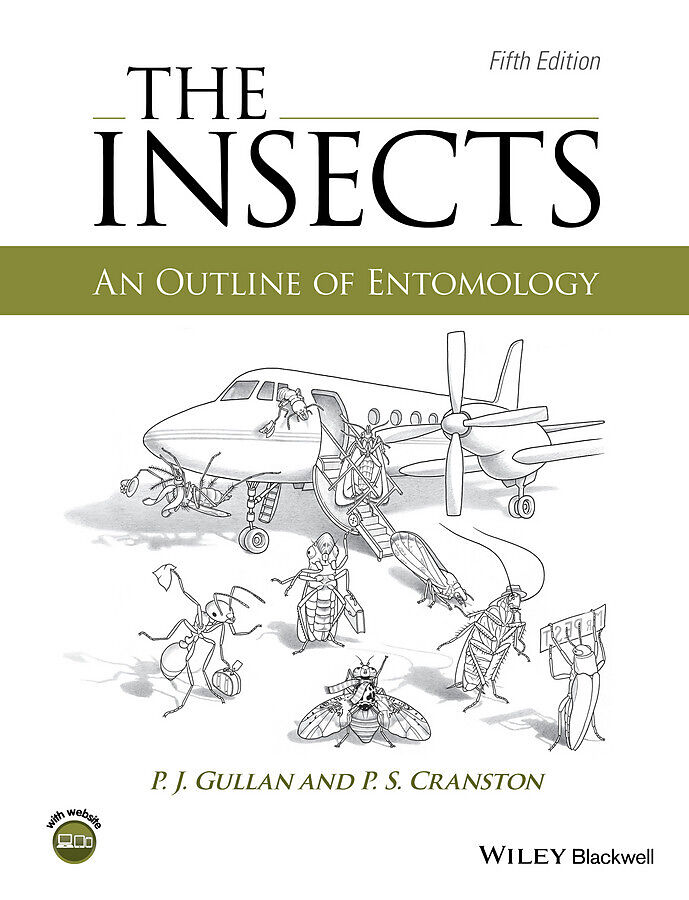Insects
Einband:
E-Book (epub)
EAN:
9781118846162
Autor:
P. J. Gullan, P. S. Cranston
Herausgeber:
Wiley-Blackwell
Erscheinungsdatum:
26.08.2014
Insects represent over half of the planet's biological
diversity. This popular textbook provides a comprehensive
introduction to this extraordinary diversity, and places entomology
central to the theory and practice of evolutionary and ecological
studies.
Fully revised, this fifth edition opens with a chapter
concerning the popular side of insect studies, including insects in
citizen science, zoos and butterfly houses, and insects as food for
humans and animals. Key features of insect
structure, function, behaviour, ecology and classification are
integrated with appropriate molecular studies. Much of the
book is organized around major biological themes: living on the
ground, in water, on plants, in colonies, and as predators,
parasites/parasitoids and prey insects. A strong evolutionary theme
is maintained throughout.
There is major revision to the chapter on systematics and a new
chapter, Insects in a Changing World, includes insect responses to,
and the consequences of, both climate change and human-assisted
global alterations to distributions. Updated
'Taxoboxes' demonstrate topical issues and provide
concise information on all aspects of each of the 28 major
groupings (orders) of insects, plus the three orders of non-insect
hexapods. New boxes describe a worrying increase in insect threats
to landscape and commercial trees (including eucalypts, palms and
coffee) and explain the value of genetic data, including
evolutionary developmental biology and DNA barcoding, in insect
biodiversity studies.
The authors maintain the clarity and conciseness of earlier
editions, and extend the profuse illustrations with new hand-drawn
figures. Over 50 colour photographs, together with the informative
text and an accompanying website with links to video clips,
appendices, textboxes and further reading lists, encourage a deeper
scientific study of insects. The book is intended as the principal
text for students studying entomology, as well as a reference text
for undergraduate and graduate courses in the fields of ecology,
agriculture, fisheries and forestry, palaeontology, zoology, and
medical and veterinary science.
Autorentext
Penny Gullan and Peter Cranston are adjunct professors in Evolution, Ecology and Genetics, in the Research School of Biology, The Australian National University, Canberra, Australia, where they conduct research on the biodiversity and systematics of Coccoidea and Chironomidae, respectively. Both maintain emeritus connections with the Department of Entomology and Nematology, University of California, Davis, USA.
Klappentext
Insects represent over half of the planet's biological diversity. This popular textbook provides a comprehensive introduction to this extraordinary diversity, and places entomology central to the theory and practice of evolutionary and ecological studies. Fully revised, this fifth edition opens with a chapter concerning the popular side of insect studies, including insects in citizen science, zoos and butterfly houses, and insects as food for humans and animals. Key features of insect
structure, function, behaviour, ecology and classification are integrated with appropriate molecular studies. Much of the book is organized around major biological themes: living on the ground, in water, on plants, in colonies, and as predators, parasites/parasitoids and prey insects. A strong evolutionary theme is maintained throughout. There is major revision to the chapter on systematics and a new chapter, Insects in a Changing World, includes insect responses to, and the consequences of, both climate change and human-assisted global alterations to distributions. Updated 'Taxoboxes' demonstrate topical issues and provide concise information on all aspects of each of the 28 major groupings (orders) of insects, plus the three orders of non-insect hexapods. New boxes describe a worrying increase in insect threats to landscape and commercial trees (including eucalypts, palms and coffee) and explain the value of genetic data, including evolutionary developmental biology and DNA barcoding, in insect biodiversity studies.
The authors maintain the clarity and conciseness of earlier editions, and extend the profuse illustrations with new hand-drawn figures. Over 50 colour photographs, together with the informative text and an accompanying website with links to video clips, appendices, textboxes and further reading lists, encourage a deeper scientific study of insects. The book is intended as the principal text for students studying entomology, as well as a reference text for undergraduate and graduate courses in the fields of ecology, agriculture, fisheries and forestry, palaeontology, zoology, and medical and veterinary science.
Inhalt
List of Colour Plates ix List of Boxes xiii Preface to the fifth edition xv Preface to the fourth edition xvii Preface to the third edition xix Preface to the second edition xxi Preface and acknowledgments for first edition xxiii About the companion website xxv 1 The Importance Diversity and Conservation of Insects 1 1.1 What is entomology? 2 1.2 The importance of insects 2 1.3 Insect biodiversity 6 1.4 Naming and classification of insects 10 1.5 Insects in popular culture and commerce 11 1.6 Culturing insects 13 1.7 Insect conservation 14 1.8 Insects as food 20 Further reading 25 2 External Anatomy 26 2.1 The cuticle 27 2.2 Segmentation and tagmosis 33 2.3 The head 35 2.4 The thorax 45 2.5 The abdomen 52 Further reading 55 3 Internal Anatomy and Physiology 56 3.1 Muscles and locomotion 57 3.2 The nervous system and co-ordination 63 3.3 The endocrine system and the function of hormones 66 3.4 The circulatory system 69 3.5 The tracheal system and gas exchange 73 3.6 The gut digestion and nutrition 77 3.7 The excretory system and waste disposal 86 3.8 Reproductive organs 90 Further reading 93 4 Sensory Systems and Behaviour 95 4.1 Mechanical stimuli 96 4.2 Thermal stimuli 105 4.3 Chemical stimuli 107 4.4 Insect vision 117 4.5 Insect behaviour 122 Further reading 124 5 Reproduction 125 5.1 Bringing the sexes together 126 5.2 Courtship 128 5.3 Sexual selection 128 5.4 Copulation 131 5.5 Diversity in genitalic morphology 136 5.6 Sperm storage fertilization and sex determination 139 5.7 Sperm competition 140 5.8 Oviparity (egg-laying) 144 5.9 Ovoviviparity and viviparity 150 5.10 Other modes of reproduction 150 5.11 Physiological control of reproduction 153 Further reading 154 6 Insect Development and Life Histories 156 6.1 Growth 157 6.2 Life-history patterns and phases 158 6.3 Process and control of moulting 169 6.4 Voltinism 172 6.5 Diapause 173 6.6 Dealing with environmental extremes 174 6.7 Migration 178 6.8 Polymorphism and polyphenism 180 6.9 Age-grading 181 6.10 Environmental effects on development 183 Further reading 188 7 Insect Systematics: Phylogeny and Classification 190 7.1 Systematics 191 7.2 The extant Hexapoda 201 7.3 Informal group Entognatha: Collembola (springtails) Diplura (diplurans) and Protura (proturans) 202 7.4 Class Insecta (true insects) 203 Further reading 224 8 Insect Evolution And Biogeography 227 8.1 Relationships of the Hexapoda to other Arthropoda 228

Leider konnten wir für diesen Artikel keine Preise ermitteln ...
billigbuch.ch sucht jetzt für Sie die besten Angebote ...
Die aktuellen Verkaufspreise von 6 Onlineshops werden in Realtime abgefragt.
Sie können das gewünschte Produkt anschliessend direkt beim Anbieter Ihrer Wahl bestellen.
Loading...
Die aktuellen Verkaufspreise von 6 Onlineshops werden in Realtime abgefragt.
Sie können das gewünschte Produkt anschliessend direkt beim Anbieter Ihrer Wahl bestellen.
| # | Onlineshop | Preis CHF | Versand CHF | Total CHF | ||
|---|---|---|---|---|---|---|
| 1 | Seller | 0.00 | 0.00 | 0.00 |
